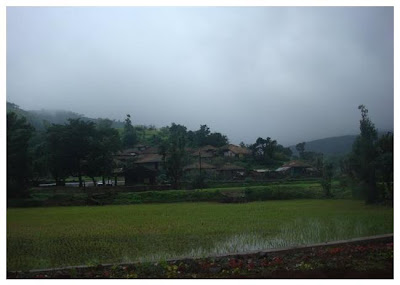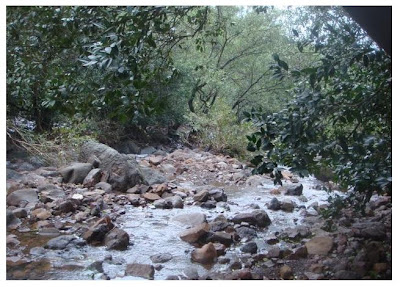
via: Flickr








 via:Root Bridges
via:Root Bridges



















 Images Via: http://photos.ibibo.com/photo/3726562/ratangad
Images Via: http://photos.ibibo.com/photo/3726562/ratangad

 The continent lies on the equator on the eastern Hemisphere . The widest port of the continent measures to 7400 km The longest part stretching from Cape Blanc, Tanisla in he North to Cape Agulhas , South Africa in the south measures to around 8050 km. Suez Canal separates the continent from Asia. The Sinai Peninsula, which lies in Asia, connects it with Africa in the form of a land bridge. But is separated by the Suez canal and gulf of Suez Mediterranean sea separates Africa from Europe. Africa land masses is bordered by Atlantic ocean on the west and Indian ocean in the south.
The major African islands found in the Indian ocean are Madagascar, Mauritius, Seychelles Comoros, Zanzibar , Reunion and Pemba. The islands in Atlantic ocean are Madiera, Canary, Cape Verdi, Ascention and Saint Heling Bioko, Annoban, Sao Tome and Principe are the islands in the gulf of Guinea.
Land and Resource
World's largest desert, Sahara and the world's largest river Nile is in Africa. The land mass of Africa wear severe contrast . There is a striking contrast between the wet tropical , central Africa and the mountainous northern Africa. The Ethiopian waterfall and the lush green vegetation lining the banks of Nile is simply beautiful. The countries in the continent includes Algeria, Morocco, Tunisia, Libya, Egypt, Mauritius Mali, Nigeria, Sudan, Chad, Ethiopia, Guinea, Senegal Liberia, Ivory coast, Lagos, Cameroon, Gabon, Congo, Zaire, Uganda, Kenya, Tanzania, Somalia, Angola, Zambia, Zimbabwe Mozambique, Namibia, Botswana South Africa, and Madagascar Kilimanjaro forms the tallest mountain of Africa raising to a height of 5895 m above the grasslands of Amboseli, Park Kenya . This land mast is home for a great variety of wild life and cover 40 percent of Africa's land . The Victoria falls, one of the highest natural waterfalls in the world is in the Zambezi river of South central Africa. The Kariba Arch dam create behind it one of the largest water bodies in the world, the lake Victoria.
Languages
Population of Africa speak more than 1000 languages, thus becoming one of the most complex language areas in the world. About 100 million people speak bantu language and is the most widely spoken language in Southern Africa. The Khoisan language is spoken by San and Khoikhoi of Namibia. English, French and Arabic are widely used and are the common business languages for Afrikaans.
Climate
Lying along the equator, Africa is hot and humid. Towards the North- West it is temperate. In the South, near Cape of Good Hope and several inland plateaus the climate is Mediterranean. Deserts along the equator are very hot during the day and cold at night. The desert in the North is Sahara and in the South it is Namib and Kalahari. Average temperature ranges from 25 Deg.Celsius (77F) at the equator to 37 Deg.Celsius (99F) in desert regions to 10 Deg.Celsius (50F) at the northern and southern extremes.
Wild Life
African Terrains have almost all remaining species of wild life prevailing on Earth. Most commonly found are antelopes, girraffes, zebras and the animal that pey on them including hyenas, jackals, leopard and lions. Extensice killing of elephants made them migrate to safer from zones of the eastern and south eastern Africa. Ran forest are home for gorillas, buffellos, monkeys, chimpanzees and wild pigs. Baboons too are quite common , in grass lands. Frogs , teads, snakes, crocodiles, hippopotamuses and lizards are widely found in tropical rivers. Africa's largest snakes the rock python grows to a length of 8m(25 ft.). Rana qoliath, found in Cameroon weighs up to 4.5 kg and is the largest in the world.
Africa is the home for almost 2300 species of birds. Flamingos, pelicans, storks, ostriches, pheasants, dove, kingfisher, horn bill, cowl, parrot, duck, goose, hevenwarbler, sunbird and hawk live in different regions of Africa. Eagles, bustards, falcons and quails are found in the open grassland.
Tourist Attractions
Kruger National Park, South Africa.
Serengeti National Park, Tanzania.
Marsabit National reserve, Kenya.
Kafue National Park, Zambia.
Sahara desert.
Nile river Egypt.
Namib desert.
Kalahari desert
Victoria falls, Zimbabwe.
Zambezi river.
Congo river.
Ethiopian river.
Kilimanjaro mountain.
Savannas, grass lands, Kenya.
Orange river.
Kariba dam, Zimbabwe.
Lake Victoria.
Important cities
Algiers (Algeria), Kumpala (Uganda), Tripoli (Libya), Conakry (Guinia), Addis Ababa (Ethiopia), Lagos (Nigeria), Kinshasa (Zoire), Nairobi (Kenya) and Johannesburg (South Africa).
Area : 30300000 Sq Km, 25 % of the world's total land mass.
Population: 922,011,000 in 2005.
Coastline : 30500 Km (18950m).
Elevation : Highest Kilimanjaro (19340), Lowest : Loka Assel, 155 m below sea level.
Principal rivers : Nile, Congo, Niger, Zambezi, Orange, Volta.
Principal Lakes: Victoria, Tangnyika, Nuasa.
Principal mountain range : Atlas, Rwenzori, Drakensberg, Cameroon.
Principal deserts : Sahara, Kalahari, Namib
Largest city : Cairo
Busiest port : Durban.
Most popular country: Nigeria.
Political divisions : 51 independent countries
The continent lies on the equator on the eastern Hemisphere . The widest port of the continent measures to 7400 km The longest part stretching from Cape Blanc, Tanisla in he North to Cape Agulhas , South Africa in the south measures to around 8050 km. Suez Canal separates the continent from Asia. The Sinai Peninsula, which lies in Asia, connects it with Africa in the form of a land bridge. But is separated by the Suez canal and gulf of Suez Mediterranean sea separates Africa from Europe. Africa land masses is bordered by Atlantic ocean on the west and Indian ocean in the south.
The major African islands found in the Indian ocean are Madagascar, Mauritius, Seychelles Comoros, Zanzibar , Reunion and Pemba. The islands in Atlantic ocean are Madiera, Canary, Cape Verdi, Ascention and Saint Heling Bioko, Annoban, Sao Tome and Principe are the islands in the gulf of Guinea.
Land and Resource
World's largest desert, Sahara and the world's largest river Nile is in Africa. The land mass of Africa wear severe contrast . There is a striking contrast between the wet tropical , central Africa and the mountainous northern Africa. The Ethiopian waterfall and the lush green vegetation lining the banks of Nile is simply beautiful. The countries in the continent includes Algeria, Morocco, Tunisia, Libya, Egypt, Mauritius Mali, Nigeria, Sudan, Chad, Ethiopia, Guinea, Senegal Liberia, Ivory coast, Lagos, Cameroon, Gabon, Congo, Zaire, Uganda, Kenya, Tanzania, Somalia, Angola, Zambia, Zimbabwe Mozambique, Namibia, Botswana South Africa, and Madagascar Kilimanjaro forms the tallest mountain of Africa raising to a height of 5895 m above the grasslands of Amboseli, Park Kenya . This land mast is home for a great variety of wild life and cover 40 percent of Africa's land . The Victoria falls, one of the highest natural waterfalls in the world is in the Zambezi river of South central Africa. The Kariba Arch dam create behind it one of the largest water bodies in the world, the lake Victoria.
Languages
Population of Africa speak more than 1000 languages, thus becoming one of the most complex language areas in the world. About 100 million people speak bantu language and is the most widely spoken language in Southern Africa. The Khoisan language is spoken by San and Khoikhoi of Namibia. English, French and Arabic are widely used and are the common business languages for Afrikaans.
Climate
Lying along the equator, Africa is hot and humid. Towards the North- West it is temperate. In the South, near Cape of Good Hope and several inland plateaus the climate is Mediterranean. Deserts along the equator are very hot during the day and cold at night. The desert in the North is Sahara and in the South it is Namib and Kalahari. Average temperature ranges from 25 Deg.Celsius (77F) at the equator to 37 Deg.Celsius (99F) in desert regions to 10 Deg.Celsius (50F) at the northern and southern extremes.
Wild Life
African Terrains have almost all remaining species of wild life prevailing on Earth. Most commonly found are antelopes, girraffes, zebras and the animal that pey on them including hyenas, jackals, leopard and lions. Extensice killing of elephants made them migrate to safer from zones of the eastern and south eastern Africa. Ran forest are home for gorillas, buffellos, monkeys, chimpanzees and wild pigs. Baboons too are quite common , in grass lands. Frogs , teads, snakes, crocodiles, hippopotamuses and lizards are widely found in tropical rivers. Africa's largest snakes the rock python grows to a length of 8m(25 ft.). Rana qoliath, found in Cameroon weighs up to 4.5 kg and is the largest in the world.
Africa is the home for almost 2300 species of birds. Flamingos, pelicans, storks, ostriches, pheasants, dove, kingfisher, horn bill, cowl, parrot, duck, goose, hevenwarbler, sunbird and hawk live in different regions of Africa. Eagles, bustards, falcons and quails are found in the open grassland.
Tourist Attractions
Kruger National Park, South Africa.
Serengeti National Park, Tanzania.
Marsabit National reserve, Kenya.
Kafue National Park, Zambia.
Sahara desert.
Nile river Egypt.
Namib desert.
Kalahari desert
Victoria falls, Zimbabwe.
Zambezi river.
Congo river.
Ethiopian river.
Kilimanjaro mountain.
Savannas, grass lands, Kenya.
Orange river.
Kariba dam, Zimbabwe.
Lake Victoria.
Important cities
Algiers (Algeria), Kumpala (Uganda), Tripoli (Libya), Conakry (Guinia), Addis Ababa (Ethiopia), Lagos (Nigeria), Kinshasa (Zoire), Nairobi (Kenya) and Johannesburg (South Africa).
Area : 30300000 Sq Km, 25 % of the world's total land mass.
Population: 922,011,000 in 2005.
Coastline : 30500 Km (18950m).
Elevation : Highest Kilimanjaro (19340), Lowest : Loka Assel, 155 m below sea level.
Principal rivers : Nile, Congo, Niger, Zambezi, Orange, Volta.
Principal Lakes: Victoria, Tangnyika, Nuasa.
Principal mountain range : Atlas, Rwenzori, Drakensberg, Cameroon.
Principal deserts : Sahara, Kalahari, Namib
Largest city : Cairo
Busiest port : Durban.
Most popular country: Nigeria.
Political divisions : 51 independent countries













When Eiffel Tower is celebrating the 125th anniversary of its existence, the authorities are considering a major face lift for this "beauty queen" of Europe! When Eiffel tower is getting a make up it could not be a meager deal. The estimated budget allocated for this cause is about 5 million US dollars. A special team of 25 painters from Greece and Romania are doing the make up. Usually the joints along with the nuts and bolts get painted every 7 years. But this time a special paint from Norway is used to paint the Eiffel tower.

It is not easy to paint such mammoth structure. "Eiffel tower brown," a patented paint of 60 tonnes are required for the job. Painting rope up to a length of 50 Km. are also required and guess what? It will be 18 month before the last brush stroke is made.






























